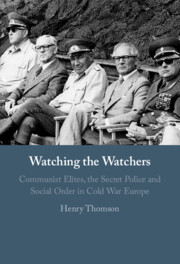Book contents
- Frontmatter
- Dedication
- Contents
- Figures
- Tables
- Acknowledgments
- Part I Introduction and Theory
- Part II Comparative Historical Analysis: Polish People’s Republic and the German Democratic Republic
- 3 Introduction to Part II
- 4 The Polish People’s Republic
- 5 The German Democratic Republic
- Part III Cross-national Quantitative Analysis
- Part IV Conclusion
- Appendix A Secret Police Agencies and Chiefs in Socialist Central and Eastern Europe, 1945–1989
- Appendix B Survival Analysis, Chapter 7
- Appendix C Agency Size Analysis, Chapter 8
- Bibliography
- Index
4 - The Polish People’s Republic
from Part II - Comparative Historical Analysis: Polish People’s Republic and the German Democratic Republic
Published online by Cambridge University Press: 22 February 2024
- Frontmatter
- Dedication
- Contents
- Figures
- Tables
- Acknowledgments
- Part I Introduction and Theory
- Part II Comparative Historical Analysis: Polish People’s Republic and the German Democratic Republic
- 3 Introduction to Part II
- 4 The Polish People’s Republic
- 5 The German Democratic Republic
- Part III Cross-national Quantitative Analysis
- Part IV Conclusion
- Appendix A Secret Police Agencies and Chiefs in Socialist Central and Eastern Europe, 1945–1989
- Appendix B Survival Analysis, Chapter 7
- Appendix C Agency Size Analysis, Chapter 8
- Bibliography
- Index
Summary
In this chapter, I demonstrate how the shock of Stalin’s death in 1953 caused a collapse in the cohesion of the Polish communist ruling coalition. This breakdown caused a persistent decline in the regime’s coercive capacity. The transition to a post-Stalinist ruling coalition in Warsaw removed the institutional basis for cooperation among PZPR elites. The highest echelons of the communist regime could no longer agree on an appropriate repressive policy or effectively monitor and control their coercive agents. The reformed and reduced post-Stalinist secret police simply did not employ enough agents and secret informants to effectively monitor and repress opponents. Opposition to the communist government among industrial workers and university students crystallized in the 1960s, persisted for decades, and became organized in durable social movements. By the late 1970s, the Polish regime faced a large, well-organized opposition movement in the trade union, Solidarity. The imposition of martial law and reconstruction of the security apparatus after the militarization of the regime in 1980 were too little, too late for the PZPR regime.
Keywords
- Type
- Chapter
- Information
- Watching the WatchersCommunist Elites, the Secret Police and Social Order in Cold War Europe, pp. 100 - 139Publisher: Cambridge University PressPrint publication year: 2024



